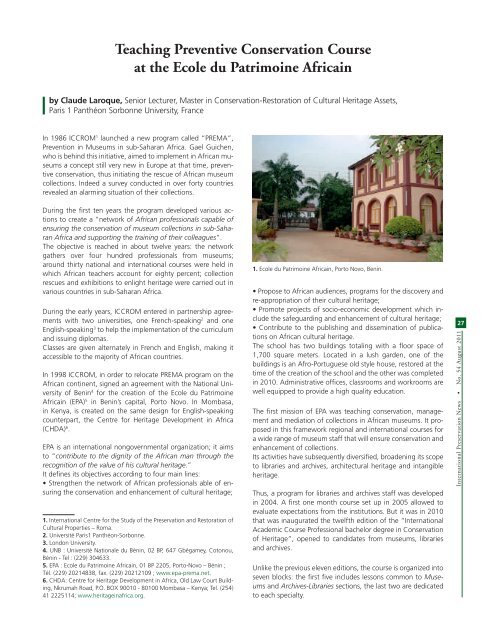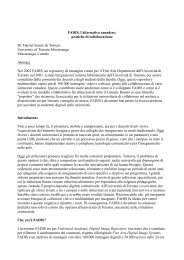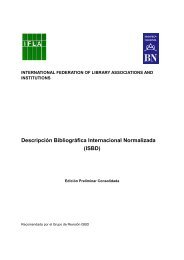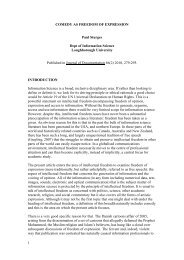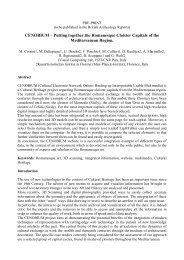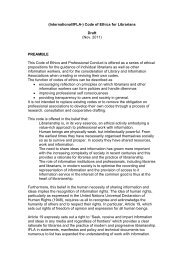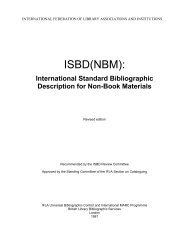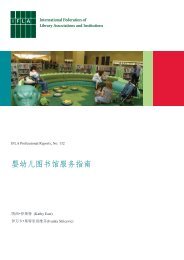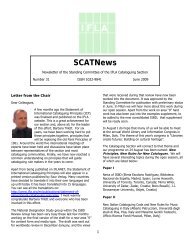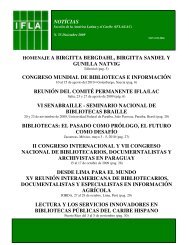N o 54 - IFLA
N o 54 - IFLA
N o 54 - IFLA
You also want an ePaper? Increase the reach of your titles
YUMPU automatically turns print PDFs into web optimized ePapers that Google loves.
Teaching Preventive Conservation Course<br />
at the Ecole du Patrimoine Africain<br />
by Claude Laroque, Senior Lecturer, Master in Conservation-Restoration of Cultural Heritage Assets,<br />
Paris 1 Panthéon Sorbonne University, France<br />
In 1986 ICCROM 1 launched a new program called “PREMA”,<br />
Prevention in Museums in sub-Saharan Africa. Gael Guichen,<br />
who is behind this initiative, aimed to implement in African museums<br />
a concept still very new in Europe at that time, preventive<br />
conservation, thus initiating the rescue of African museum<br />
collections. Indeed a survey conducted in over forty countries<br />
revealed an alarming situation of their collections.<br />
During the first ten years the program developed various actions<br />
to create a “network of African professionals capable of<br />
ensuring the conservation of museum collections in sub-Saharan<br />
Africa and supporting the training of their colleagues”.<br />
The objective is reached in about twelve years: the network<br />
gathers over four hundred professionals from museums;<br />
around thirty national and international courses were held in<br />
which African teachers account for eighty percent; collection<br />
rescues and exhibitions to enlight heritage were carried out in<br />
various countries in sub-Saharan Africa.<br />
During the early years, ICCROM entered in partnership agreements<br />
with two universities, one French-speaking 2 and one<br />
English-speaking 3 to help the implementation of the curriculum<br />
and issuing diplomas.<br />
Classes are given alternately in French and English, making it<br />
accessible to the majority of African countries.<br />
In 1998 ICCROM, in order to relocate PREMA program on the<br />
African continent, signed an agreement with the National University<br />
of Benin 4 for the creation of the Ecole du Patrimoine<br />
Africain (EPA) 5 in Benin’s capital, Porto Novo. In Mombasa,<br />
in Kenya, is created on the same design for English-speaking<br />
counterpart, the Centre for Heritage Development in Africa<br />
(CHDA) 6 .<br />
EPA is an international nongovernmental organization; it aims<br />
to “contribute to the dignity of the African man through the<br />
recognition of the value of his cultural heritage.”<br />
It defines its objectives according to four main lines:<br />
• Strengthen the network of African professionals able of ensuring<br />
the conservation and enhancement of cultural heritage;<br />
1. International Centre for the Study of the Preservation and Restoration of<br />
Cultural Properties – Roma.<br />
2. Université Paris1 Panthéon-Sorbonne.<br />
3. London University.<br />
4. UNB : Université Nationale du Bénin, 02 BP, 647 Gbégamey, Cotonou,<br />
Bénin - Tel : (229) 304633.<br />
5. EPA : Ecole du Patrimoine Africain, 01 BP 2205, Porto-Novo – Bénin ;<br />
Tél. (229) 20214838, fax. (229) 20212109 ; www.epa-prema.net.<br />
6. CHDA: Centre for Heritage Development in Africa, Old Law Court Building,<br />
Nkrumah Road, P.O. BOX 90010 - 80100 Mombasa – Kenya; Tel. (2<strong>54</strong>)<br />
41 2225114; www.heritageinafrica.org.<br />
1. Ecole du Patrimoine Africain, Porto Novo, Benin.<br />
• Propose to African audiences, programs for the discovery and<br />
re-appropriation of their cultural heritage;<br />
• Promote projects of socio-economic development which include<br />
the safeguarding and enhancement of cultural heritage;<br />
• Contribute to the publishing and dissemination of publications<br />
on African cultural heritage.<br />
The school has two buildings totaling with a floor space of<br />
1,700 square meters. Located in a lush garden, one of the<br />
buildings is an Afro-Portuguese old style house, restored at the<br />
time of the creation of the school and the other was completed<br />
in 2010. Administrative offices, classrooms and workrooms are<br />
well equipped to provide a high quality education.<br />
The first mission of EPA was teaching conservation, management<br />
and mediation of collections in African museums. It proposed<br />
in this framework regional and international courses for<br />
a wide range of museum staff that will ensure conservation and<br />
enhancement of collections.<br />
Its activities have subsequently diversified, broadening its scope<br />
to libraries and archives, architectural heritage and intangible<br />
heritage.<br />
Thus, a program for libraries and archives staff was developed<br />
in 2004. A first one month course set up in 2005 allowed to<br />
evaluate expectations from the institutions. But it was in 2010<br />
that was inaugurated the twelfth edition of the “International<br />
Academic Course Professional bachelor degree in Conservation<br />
of Heritage”, opened to candidates from museums, libraries<br />
and archives.<br />
Unlike the previous eleven editions, the course is organized into<br />
seven blocks: the first five includes lessons common to Museums<br />
and Archives-Libraries sections, the last two are dedicated<br />
to each specialty.<br />
27<br />
International Preservation News • No. <strong>54</strong> August 2011


